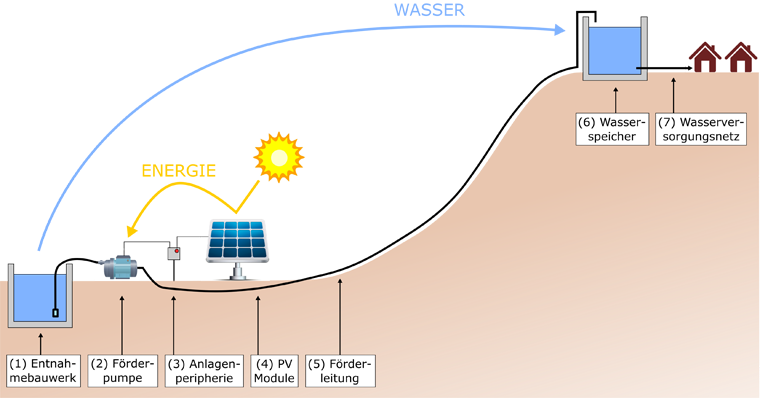Water Pumping – Photovoltaic-based Pump Systems

Background
In order to be able to implement water pumping based on renewable energy forms even in locations that have no and/or insufficient hydroelectric potential, photovoltaic-based pump systems (PVPS) present a sensible alternative to hydroelectric pumping units. Through the independence of hydroelectric potential, very low amounts of runoff make economic utilization possible. Also with regards to the spatially distributed settlement structure, one can develop places in extremely peripheral locations such as farmsteads, homesteads, and very small settlements, to which, due to technical and/or economic aspects, it is neither possible nor sensible to link existing supply networks. Sharply falling acquisition costs also favor the high applicability of PVPS. For instance, the price of crystalline PV modules with a nominal output of one watt-peak dropped by approx. 45% between 2012 and 2017.
Apart from the PV modules for converting radiation energy into electricity, other main components of a PVPS are the intake structure, the unit comprising the feed pump and the motor as well as the feed pipes and the water tank. There are also plant peripherals that comprise added electrical components for facility control such as charge controllers, if necessary, frequency inverters etc.

Schematic illustration of a photovoltaic-based pump system with labeling of the main components
There is great technical and economic interest in the application of PVPS in Vietnam in particular, because almost all parts of the country experience high radiation intensity and there is enormous demand in the numerous, extremely rural regions regarding the improvement of existing water supply using decentralized methods.
Objective
Apart from immediately improving the supply situation for the population in Dong Van Region, the pilot implementation of PVPS is intended to provide practical experience for future multiplication projects. A GIS-based analysis is to be carried out to identify suitable locations in the project region, with, among other things, the location of underground and aboveground water resources being spatially merged with local settlement structures as well as with available radiation maps.
There is an added focus on developing a highly efficient progressive cavity pump with innovative displacement geometry and high tolerance of sediment load. Additionally, there are plans to develop an innovative control system in order to enable the pump itself to automatically detect and remove blockages. This automatic protective system is not limited to being utilized in PVPS and thus offers varied possibilities for application in pump systems for different operational purposes.
